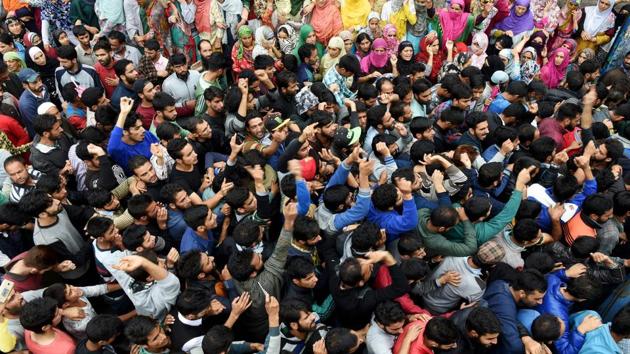Hizbul Mujahideen names Mohammad Bin Qasim as new commander
The death of 40-year-old Itoo alias Mehmood Ghaznavi, who was named the “commander” four days after the killing of militant Burhan Wani in July last year, has come as a big blow to Hizb.
Hizbul Mujahideen named Mohammad Bin Qasim as its new operational chief on Monday, a day after its commander Yasin Itoo was killed in a gunfight with security forces in south Kashmir’s Shopian that incurred a body blow to the homegrown militant outfit.

In a press statement, the Hizbul Mujahideen confirmed Itoo was its commander but like the last time did not give the real name of the new chief.
The death of 40-year-old Itoo alias Mehmood Ghaznavi, who was named the “commander” by United Jihad Council chief Syed Salahuddin four days after the killing of militant Burhan Wani in July last year, has come as a big blow to the Hizbul Mujahideen.
The time of Itoo’s killing is important as the militant outfit is left with only a few known commanders and is fighting the rise in popularity of their breakaway commander Zakir Musa, who claims to be fighting for the formation of an Islamic State. Musa was recently named as its local commander by global terror outfit al Qaeda.
Sources said Qasim could be either Riyaz Naikoo, the district commander of Pulwama, or Altaf Kachroo, commander of the outfit in Kulgam. Both are category A ++ militants and figure in the list of top 12 militants released by the Indian Army after Bhat’s killing.
Security establishment classifies militants as ‘A’ or ‘A++’, ranking them in an order of notoriety with ‘A++’ denoting the highest.
Most intelligence sources agreed Naikoo, a resident Tokun Awantipore in south Kashmir, is more likely to be Qasim.
Naikoo has been releasing video statements and is a well-known militant who joined the organisation in December 2012.
The 30-year-old postgraduate is known to be ideologically opposed to the “Islamic State slogan’’ of Musa and has also appeared at the funerals of militants killed in encounters with the army and police.
“Linking our (Kashmiri) struggle with al Qaeda and ISIS is a ploy to defame it,” he reportedly said at one such funeral in July this year in Pulwama district. Naikoo also asked people not to support those “who oppose the Pakistani flag” and described their struggle as one of “freedom from India”.
The Hizbul Mujahideen statement on Monday also tried to reinforce that the killing has not weakened the organisation. “Indian agencies thought that post-Wani’s death ... the struggle for independence has been weakened but each sacrifice of militants proves otherwise,’’ the statement signed by spokesperson Saleem Hashmi said.
Sources in security establishments, however, think otherwise. They said the organisation does not have “a strong central command and operates in small modules’’.
“Hizbul Mujahideen has been weakened as there are only a few hardened militants left, rest are all new recruits,’’ said an official.
The killings of the militants, security officials said, can also bring a halt to new recruitments.
After Itoo, Mujahideen has lost another public face but his death did not see the kind of reaction Kashmir witnessed after Wani was killed. Wani’s death sparked violent street protests that left nearly 100 people, most of them civilians, dead.
And, there was a spontaneous shutdown in the valley after Wani’s successor Sabzar Bhat was killed in May.
Wani led to the resurgence of Hizbul Mujahideen and local militancy after he became the poster-boy of new-age militancy posting photographs of him and 10 gun-toting youths on social media in June 2015.
Wani was the first Kashmiri militant who was unafraid of revealing his identity and credited with the surge of local militancy while alive, and even after his killing by security forces on July 8 last year.
Most of the militants from that photograph have been killed. Musa, Saddam Padder and Waseem Shah are the only three militants still active from the ‘Burhan’s boys’ photograph.
Padder, a category A+ militant is Shopian district commander of Hizbul, and Shah, another category A militant is now with Lashkar-e-Taiba. Musa has also formed an organisation called Ansar Ghazwat-ul Hind.
More than 110 militants have been killed in the valley between January and July this year. The militants, according to government sources, belong to all the organisations such as HM, LeT and Jaish-e-Mohammad.
Abu Dujana and Bashir Lashkari of the LeT were top category A ++ militants to have been killed recently.
In Monday’s statement, Hizbul Mujahideen also warned locals acting as informers with dire consequences as “they are responsible for the killings’’.





